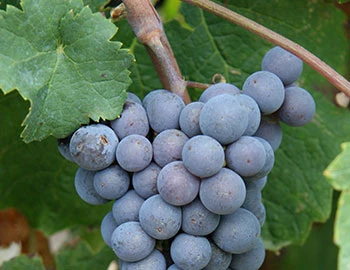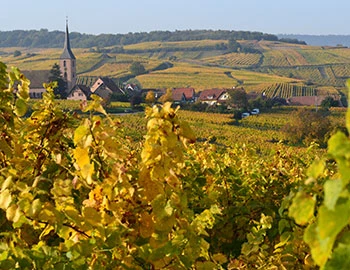Alsace Grand cru Mambourg 2019
AC Grand cru Alsace, Domaine Marcel Deiss, 750 ml

| Grape variety: | Pinot gris, Pinot noir, Pinot meunier, Pinot blanc, Pinot Beurot |
| Producer: | Domaine Marcel Deiss |
| Origin: | France / Alsace |
Description
Robert Parker, The Wine Advocate, Stephan Reinhardt writes about the vintage 2019: "The 2019 Grand Cru Mambourg offers a deep and pure bouquet with ripe stone fruit aromas intertwined with iodine and notes of crushed limestone and orange blossoms. Full-bodied, intense and bitter on the palate, this is a surprisingly matured Mambourg that shows bitters rather than complexity and rich texture. It is an impressive, pure, refined and salty wine with fine tannins, but I wonder if the best characteristics—the richness and ripeness—have not been sacrificed for the purity, but this might be a question of personal style. I personally would have expected more richness here." Powerful bouquet with aromas of yellow fruits such as pear, peach and quince. The wood is discreetly noticeable. On the palate opulent and juicy with a nice viscosity.
Attributes
| Origin: | France / Alsace |
| Grape variety: | Pinot gris, Pinot noir, Pinot meunier, Pinot blanc, Pinot Beurot |
| Label: | Certified organic or biodynamic wine |
| Ripening potential: | 5 to 20 years |
| Drinking temperature: | 10 to 12 °C |
| Food Pairing: | Crispy roast chicken, Roast veal with morel sauce, Spicy hard cheese |
| Harvest: | hand-picking, strict selection |
| Volume: | 14.0 % |
| Note: | Contains sulphites |
Pinot Beurot
synonym: Pinot Gris

Pinot meunier
Freshness boost for champagnes
Many fine white hairs on the underside of the leaves give this red grape its name. "Meunier" translates to miller, an allusion to the impression that the plant has been dusted with freshly ground flour. Its main habitat is in Champagne. Alongside Pinot noir and Chardonnay, it forms the third component of the classic champagne cuvée. It contributes fresh acidity and youthful fruit to the sparkling wines. It is only very rarely into champagne by itself, but the few examples are worth tasting. In German, Pinot Meunier is also known as Müllerrebe or misleadingly as Schwarzriesling (black Riesling).

Pinot gris
The aromas of the forest
Pinot gris is, like the Pinot blanc, a colour mutation of Pinot noir. All three have the same genetic profile. On occasion, red, grey, pink and white, berries can be observed on the same vine stock. Some are even striped! The best Pinot grises introduce themselves opulently with ripe peach and apricot aromas, slightly woody notes and a bit of smoke. These characteristics are presented, for example, in examples from Alsace, Grauburgunders from Germany, or the representatives from Valais, where the grapes are erroneously referred to as Malvoisie. In Italy, Pinot grigio from South Tyrol and Friuli win out. Wines from this variety are great culinary companions. They get along superbly with autumnal dishes such as risotto with mushrooms or chestnuts.

Pinot blanc
Lively sparkling, substantial white
The Pinot blanc has the same genetic fingerprint as Pinot gris and Pinot noir. They only differ in colour. The mutation from red to white was noted over a century ago in Burgundy. Suddenly, berries of differing colorations were hanging on the same stock. The bouquet of the Pinot blanc is fresh and floral with notes of citrus, apple, pear and apricot. In Alsace, it yields fragrant sparkling wines; it also enters into some champagnes. Vintners in Germany and Austria produce an abundance of Pinot blanc with a good deal of substance, blending and backbone. Representatives from Switzerland demonstrate a similar profile. There, the Pinot blanc grows mainly in Valais, Vaud and in Grisons.

Pinot noir
Blueprint of the terroir
No other variety expresses its terroir as precisely as Pinot noir. It is a sensitive, fragile grape. But when it succeeds, it gives the world some of its very greatest wine plants. It especially excels in Burgundy, where it has been cultivated for at least 700 years. Even in the middle ages, it was considered so precious that it was kept separate from other grapes so as to not diminish its value. The finest examples are delicate and fragrant with aromas of cherries and red berries. With maturity, notes of forest floor, leather and truffles enter as well. An irresistible fruity sweetness still shines through, even after several decades. The Pinot noir does well in cool locations: in Switzerland and in Germany, where it is known as Blauburgunder and Spätburgunder respectively; in Alsace and in South Tyrol, in Oregon, New Zealand and Tasmania. Not least, it yields fantastic champagnes. It is a wonderful culinary companion. With its soft tannins and charming bouquet, it meshes with everything, from Güggeli and cheeses to fried fish.

Alsace
Alsace: diverse whites
The exceptional position of Alsace on the border of Germany has contributed to the fact that Alsatian wine culture contains both French and German elements. The range of grape varieties, unusual from a French perspective, is dominated by Gewürztraminer, Sylvaner and Pinot Blanc (Weissburgunder) –varieties all cultivated on the German side of the Rhine in Baden. According to the French tradition, the wines are cultivated and vinified such that they embody their respective terroirs.

France
France – Philosophy in a bottle
According to French philosophy, wine should be an expression of the soil and climate. They use the word “terroir” to describe this. Terroir makes every wine different, and many especially good. French wine is regarded worldwide as an expression of cultural perfection. The French believe that humans are responsible for the quality of the berries, the vine variety for their character, and nature for the quantity. This philosophy can be expressed succinctly as: “the truth is the vineyard, not the man.”



